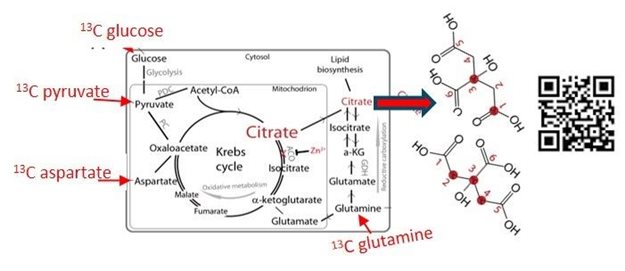
High levels of citrate in prostatic and seminal fluid contribute to an optimal environment for sperm cells. These high levels are maintained by cells in the prostate that are functionalized to secrete citrate into the luminal space of this organ.
In a recent publication in the Proceedings of the National Academy of Sciences USA, Frits van Heijster, theme urological cancers, (department of Medical Imaging) and his colleagues describe investigations to uncover which carbon sources and metabolic pathways are used by epithelial cells of the prostate to sustain high luminal citrate levels. For this purpose they supplied human prostate cancer cells, that have maintained their capacity to secrete citrate, with 13C labeled substrates such as glucose and glutamine (figure) and recorded NMR spectra of extra-cellular fluid to analyze the extent of 13C labeling of secreted citrate. As the specific 13C labeling pattern of the 6 carbons in extra-cellular citrate (red dots, figure) are a reflection of its intra-cellular synthesis pathways it is possible to use these patterns as a “QR code” to read intra-cellular metabolism. In addition a model of intra-cellular metabolism, involved in citrate synthesis, was developed. An analysis of metabolic fluxes and flow of 13C carbons with this model provided direct evidence that carbons from glucose, following specific pathways, are the main contributors to citrate secreted by the cells. Interestingly, supplied glutamine also contributes carbons to secreted citrate, but further quantitative analysis indicates it probably contributes little to its net synthesis in this prostate cell system.
In contrast to common assessments of cellular metabolism by analyzing intracellular conversion of metabolites this study assessed metabolism from the specific tracer labeling of metabolites (citrate) secreted by the cells in extracellular fluid. Extracellular fluid of prostate cells and of the prostate, such as prostatic and seminal fluid and urine, can be obtained relatively easy. Thus the analysis of their metabolites, in particular those with multiple carbons, by NMR tracing may identify (malignant) intracellular metabolic transformations and potential molecular targets for therapies.

read more
Related news items
.aspx?width=439&height=263&ext=.png&type=BlockColumn1Zoom1)
Vote for the RIMLS Supervisor of the year
7 December 2021This is your chance to vote for your favourite candidate for supervisor of the year! Support and promote your ideal supervisor from the three nominees: Siroon Bekkering, Gerald Verhaegh and Jo Zhou. Please submit your vote the 20th of December 2021 at the latest.
go to page
RIMLS awards call for nominations
19 October 2021 RIMLS awards several prizes to stimulate and honor our (young) researchers. Upcoming awards are Supervisor of the Year, Best Master Thesis, Best Publication, Best Image and more. Send your nominations now before 24 November 2021. go to page
Turbo Grants for four medical-technical research projects
19 October 2021 Four TURBO grants were recently awarded to new technical-medical research proposals. The grants are part of the TURBO program, a collaboration between the University of Twente (TechMed Centre) and the Radboudumc. go to page
Research into treatment for bladder pain syndrome will now be reimbursed
4 August 2021 Bladder pain syndrome, also called interstitial cystitis, is a chronic benign condition of the urinary bladder go to page
RIMLS online award ceremony proudly presenting the winners
13 January 2021In this special webinar of the RIMLS New Year Celebration, scientific director René Bindels reviewed 2020 and looked forward to 2021. But more importantly a number of researchers received prizes in the traditional RIMLS awards ceremony.
go to page
